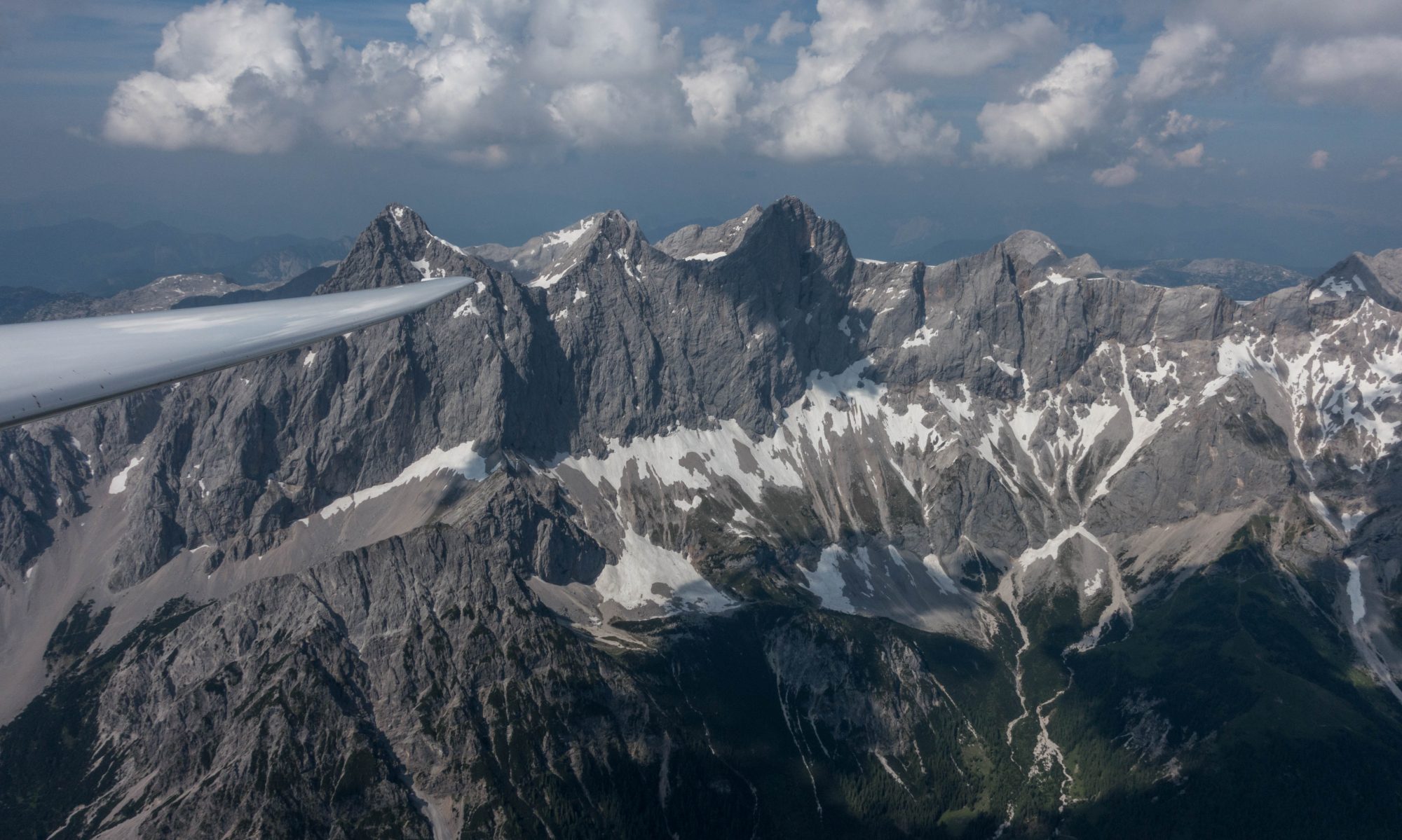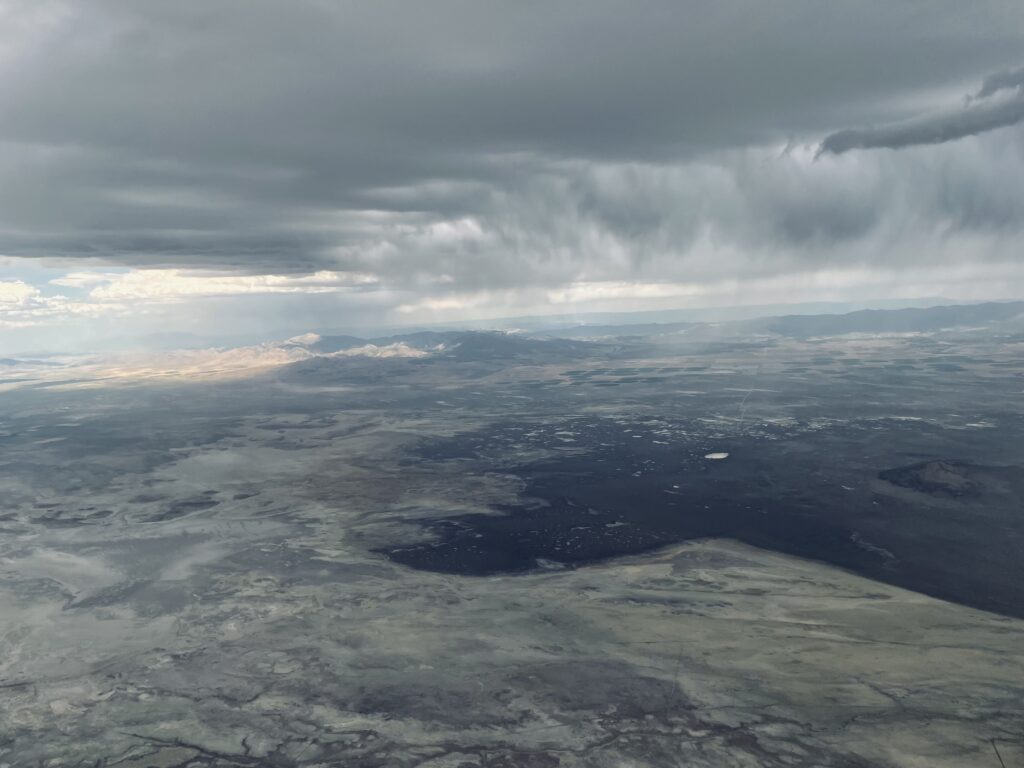Day 5 at the 18m Nationals in Nephi had it all: 15 kt lift and 15 kt sink. Long glides across big blue holes over unlandable terrain with totally still air. We had heat, storms, rain, snow, and graupel showers. We were fighting against being pulled up into the clouds and minutes later we were fighting to stay airborne. We worked with dust devils and massive gust fronts. We were flying in huge gaggles and alone in the wilderness. We also had to avoid a wildfire TFR and a Restricted Area that occupied about a third of the second turn cylinder. The flight was spectacular and exhausting. Calling the day dynamic would be a total understatement. We had two landouts but everyone is safe and accounted for.
Our task was an Assigned Area Task (AAT) with turn areas at Whiskey Knoll (40km radius), Drum Mountains (20 km), and GB Intersection (40 km). Nominal distance was 540 km. Minimum task time was 3:30.
Getting up from tow was a challenge and some pilots had to come back for a relight. I was second on the grid and stayed in my weak climb off tow and saw its strength gradually improve until I was up at cloud base. Getting the entire fleet up took a long time and the start gate opening time had to be pushed back several times.
The weather forecast was for overdevelopment in several parts of the task area and when the gate opened there was already ample evidence of that to the south.
When the gate eventually opened everyone was keen to get going. I left as part of a large group that crossed the valley immediately after crossing the start line to get under a dark cloud line line that curved from the San Pitch Mountains into the first turn cylinder. The bulk when straight for the darkest clouds but by the looks of the line I was pretty sure that the strongest part would be on the western edge. I resisted the temptation to follow the crowd and was well rewarded with 5-10 kt climb rates in straight flight. By the time we reached the southern tip of the San Pitch Mountains I was up at 17,000 feet and looked down on a conga line of gliders a few miles further east and many thousand feet below. Now that felt good!
I upped my speed to 110 kts and kept racing along the convergence towards a dark wall that had built up further south: a massive, impenetrable storm front was moving in opposite direction, directly towards us. A look at the map suggested that the front was just about at the northern edge of the turn cylinder. It was a race against time and I hoped that I would get there before I would get into rain.
There was a big drop in cloud bases as I got near the front and I had to take out the spoilers to destroy several thousand feet of altitude to stay well below the clouds. But I figured whoever came after me would have an even harder time because the front was moving fast.
I got into the cylinder and turned just before the rain. A look at my Flarm screen showed that I was now well below the conga line that was coming towards me. The vertical separation eliminated any safety concerns and I rushed back towards the lift line that had carried me south. Once the bulk of gliders had passed I took a 10 kt climb to regain the altitude I had destroyed with the air brakes and I was back up and running, turning northwest towards the Drum Mountains.
The last clouds were just west of the Canyon Mountains, then came a gaping blue hole that stretched about 60 kilometers all the way to the Drum Mountains. I downshifted info flap position 1 and trimmed my Ventus to 80 kts to fly across the desert. The contrast was stark: minutes ago I was racing all out along a strong lift line, now I had to cross a big area of completely still air.
On the other side of the gap, a big black cloud was building over the Drum Mountains. It promised good lift but only if I got there before it would also overdevelop. I was wondering if I should speed up to get there faster but that would lower my arrival altitude and diminish my safety margin in case I had to turn back towards the airport of Delta. I decided the time gain from flying 90 kts instead of 80 wasn’t worth it and I stayed with the plan that would preserve altitude. Altitude always provides the most options and that’s what I like to have.
I reached the Drum Mountains and was surprised not to immediately find the strong lift that I had anticipated. I assumed it was probably on the west side, considering the light westerly wind and hoped that I would get there before the edge of the Restricted Airspace. Gosh, everything on this task is a close call! Fortunately the western edge of the clouds was about 2 miles away from the forbidden area and even better: there was the lift I had hoped for. I moved south along the edge of the clouds when I spotted a glider going up rapidly on the southern side of the cloud. I joined a 7-8 kt climb that got me back up to cloud base.
Off towards the third turn area further south! The sky ahead looked very complicated. To the left was a rapidly overdeveloping shelf that was off from the course line to the east. To my right was a dark line of clouds with heavy rain showers. Dust from a massive gust front on the ground marked the outflow from that storm. Don’t cross that gust front!
The Cricket Mountains directly to the south had a little bit of sun on them. The clouds overhead were dissipating, probably remnants of earlier overdevelopment in this area. I was hoping that the sun might start a new cycle of thermal development along the mountains and picked a line directly along the spine that would lead to the eastern edge of the third turn area.
I tuned my flight computer to Delta Muni, directly behind me, as this is the only safe place to land in this area. My flight computer showed that I was 4000 feet above arrival altitude at Delta at MC4. Would I be able to get into the turn cylinder before that number was down to 0?
There was only one way to find out. Once again I flew very conservatively at 80 kts to conserve altitude. There were some little bumps along the ridge that stretched my glide a bit, but I found absolutely nothing that I could have circled in.
When I got to the edge of the turn cylinder my arrival altitude at Delta had shrunk to 200 ft. Nick and turn! As soon as I heard the beep that I made it to the edge I changed course and headed back up to the north.
What difference 15 minutes can make! The cloud shelf to the east that I had hoped to fly along was now gone except that virga and rain was still falling in places. A line of dark clouds was now further north but I wasn’t sure if I would be able to reach it in time before it would blow up as well.
At least I was gaining on my arrival altitude at Delta so I had a safe place to go to if needed.
I made it around a rain shaft and saw a glider circling further east along a dark shelf, climbing at 6 kt, 7 km away. I had to cross some sink to get there and when I arrived 2000 ft below the lift was gone. But the shelf looked good and there had to be lift somewhere. Another gust front on the ground marked the way. I flew to the upwind side of the front and as expected the air was shooting up! 14 kt of lift in straight flight!
Soon I was up at 14,000 feet and had Nephi in glide. At the same time rain started to fall so I had to get out of there. I pushed northeast towards the Canyon Mountains which were in the sun with beautiful clouds on top. It looked like I could get there about 2000-3000 feet above, connect with the clouds and have an easy glide home.
Not so fast. As soon as this plan had formed in my mind I hit 12 kt of sustained sink and my altitude washed away in no time. What goes up must come down… When I reached the Canyon Mountains I was below the level of the highest peaks and in desperate need of a climb. Otherwise I would be landing out. Fortunately I had driven through this area two years ago and I knew that some of the fields below were landable. (Bruno Vassel ended up landing in one of these fields minutes later.)
But I wasn’t willing to give up so easily. There had to be some lift over the rocks. The air was quite turbulent but I found a 3 knot climb that improved with altitude. I was still far below minimum time so the strength of the lift was of no importance. As long as the air went up towards Final Glide I was willing to take it.
As I climbed I observed s new gust front rushing north from Gregs Beach towards Nephi. This could mean strong and gusty winds on the ground and I was eager to out-speed the gust front on the way home. When I was high enough to get even through heavy sink I was on my way and rushed back to the finish.
The wind on the ground was about 20 kts but blowing directly down the runway and the landing was easy and uneventful. I finished the task with more than 30 minutes undertime, which took my nominal task speed of 139 kph down to 117 kph.
It turns out that most of the fleet had to finish early today. In hindsight, one possibility would have been to continue further south in the last turn cylinder and focus my landing option on Milford instead of Delta. But I don’t know if this would have worked and how I would have come back from there. I’m happy with my decisions as they have kept me in safe gliding distance of good airports at all times.
Today’s winner was Joe Bostik (who like me also flies a Ventus 2), only 1 point ahead of Jim Lee (JS1) with Robin Clark (ASG 29) in third. Sean Fidler now leads overall ahead of Rick Indrebo and Jim Lee. John Seaborn did not have a good day and dropped down to 6th, but less than 200 points behind Sean.
My flight was good for 19th place today with 872 points which moved me up to 22nd or 23rd overall. I’m quite happy with this result, especially considering the caliber of pilots at this contest.
Trace on WeGlide: https://www.weglide.org/flight/81349
Trace on OLC: https://www.onlinecontest.org/…/gliding/flightinfo.html…
Contest Results: https://members.ssa.org/ContestResults.asp?contestId=2486&ContestDetailId=24448&ContestName=2021+18%2DMeter+Nationals+at+Nephi&ContestDate=7/4/2021&ResultsUpdate=True


